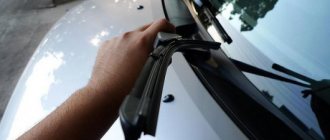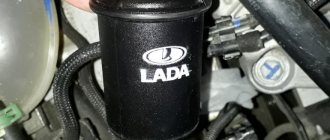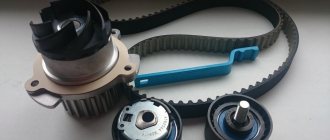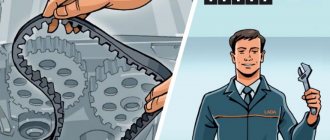LADA Vesta began production at the AvtoVAZ plant in November 2015. Equipped with motors: 11189, 21129 and HR16DE-H4M. The latter is an imported engine produced by the Renault-Nissan alliance. The most common engine size 1.6 l. 21129 - this is the well-known VAZ engine 21127 with some modernization. It is this that is taken as the basis for this routine maintenance.
The frequency of replacement of Lada Vesta consumables is 15,000 km . In severe operating conditions, it is useful to reduce the interval to 10,000 km and even more - to 7,500. There will definitely be no harm from this, except for your wallet.
First of all, reducing the replacement interval concerns the oil and oil filter. The air and cabin filters should be checked and at least blown out, and if they are heavily soiled, they must be replaced.
Severe operating conditions include:
- driving in a large city with frequent trips over short distances;
- long-term movement at low speed;
- moving through dusty areas;
- transporting a trailer or driving a heavily loaded vehicle.
Below we will describe a map of the routine maintenance of the Lada Vesta, as well as the catalog numbers of the necessary consumables and their average prices (indicated for Moscow and the region) that will be needed for work. The maintenance diagram looks like this:
Maintenance regulations for Lada Vesta
LADA Vesta began production at the AvtoVAZ plant in November 2015. Equipped with motors: 11189, 21129 and HR16DE-H4M. The latter is an imported engine produced by the Renault-Nissan alliance. The most common engine is 1.6 liter. 21129 is the well-known VAZ engine 21127 with some modernization. It is this that is taken as the basis for this routine maintenance.
The frequency of replacement of Lada Vesta consumables is 15,000 km . In severe operating conditions, it is useful to reduce the interval to 10,000 km and even more - to 7,500. There will definitely be no harm from this, except for your wallet.
First of all, reducing the replacement interval concerns the oil and oil filter. The air and cabin filters should be checked and at least blown out, and if they are heavily soiled, they must be replaced.
Severe operating conditions include:
- driving in a large city with frequent trips over short distances;
- long-term movement at low speed;
- moving through dusty areas;
- transporting a trailer or driving a heavily loaded vehicle.
Below we will describe a map of the routine maintenance of the Lada Vesta, as well as the catalog numbers of the necessary consumables and their average prices (indicated for Moscow and the region) that will be needed for work. The maintenance diagram looks like this:
At the initial stages of break-in, owners may encounter the following malfunctions:
- minor damage to the glass (it is important to undergo maintenance 0, this is often caused by defective windshield wipers);
- burnout of the resonator, its corrosion;
- wear of the engine cooling system hoses;
- rapid failure of glass heaters;
- wear of the rubber parts of the rear anti-roll bars of the Lada;
- malfunction of the lower ball joints;
- multimedia malfunctions.
These are the main “faults” of all modifications of Lada Vesta.
We advise you to pay attention to them already at the first service. Planned maintenance work should not be neglected. And the loss of warranty is not the most important thing. After all, timely maintenance is the prevention of urgent repairs, extending the service life of Lada Vesta components and a guarantee of confidence on the road.
Refueling volumes
As mentioned above, three different engines were installed on the Lada Vesta - 11189, 21129 and HR16DE-H4M. It was also equipped with different gearboxes - 2180, 2182 and JHQ. Based on this, some Vesta filling containers have different volumes, while others are the same for everyone.
The following table will help you figure out how much of a particular technical fluid needs to be filled:
| Engine lubrication system (including oil filter): 11189/21129 (stamped oil sump) 11189/21129 (cast oil sump) HR16DE-H4M | 3,2 (2,9) 4,4 (4,1) 4 |
| Cooling and heating system* : 11189/21129 HR16DE-H4M | 5,95 7,0 |
| Gearbox : Gearbox 2180/2182 JHQ | 2,25 3,34 |
| Hydraulic clutch and brake system | 0,559 |
| Hydraulic brake system (for cars with AMT) | 0,517 |
| Washer reservoir | 4,7 |
| Expansion tank (for cars with 21129 | 5.75 (max) 5.35 (min) |
| Air conditioning system (freon R134 “A”) | 0,475 (± 20) |
*A mixture of coolants of different brands should not be allowed.
In the same repair and maintenance manual for Lada West there are also the following volumes of coolant for the engine cooling system:
- for 11189/21129 with pre-heater - 9.3 l., without heating - 8.7 l.;
- for HR16DE-H4M with pre-heater – 7.6 l., without heating – 7.0 l.
List of works during maintenance 1 (15,000 km or 1 year)
- Changing the engine oil. The oil filling volume in an engine equipped with a manual transmission is 4.4 liters, and in an engine with an AMT it is supposed to be filled in 3.2 liters. It is recommended to use ROSNEFT Maximum 5W-40 motor oil, catalog number 4 l. canisters - 4291, and price - 900 rubles . There is a more expensive option - MOBIL 3000 5W40 engine oil, which has a catalog number - 150013 (4 liter canister), but the price is already 1,540 rubles.
- Replacing the oil filter. The catalog number is 21050101200500, and the price is approximately 200 rubles .
Checks during maintenance 1 and all subsequent ones:
- crankcase ventilation system;
- hoses and connections of the cooling system;
- coolant;
- exhaust system;
- fuel lines and connections;
- covers for joints of different angular velocities;
- checking the technical condition of front suspension parts;
- checking the technical condition of rear suspension parts;
- tightening the threaded connections securing the chassis to the body;
- condition of tires and air pressure in them;
- wheel alignment angles;
- steering gear;
- power steering system;
- checking the free play (play) of the steering wheel;
- hydraulic brake pipelines and their connections;
- pads, discs and drums of wheel brake mechanisms;
- vacuum booster;
- parking brake;
- brake fluid;
- checking the drive belt;
- checking the timing belt;
- accumulator battery;
- spark plug;
- headlight adjustment;
- locks, hinges, hood latch, lubrication of body fittings;
- cleaning drainage holes;
List of works for maintenance 6 (90,000 km or 6 years)
- Repeat all the procedures prescribed by TO 1, TO 2 and TO 3 - change the engine oil and oil, air and cabin filters, as well as spark plugs and brake fluid.
- Replacing the alternator belt for cars without air conditioning . Article 8450006327, price - 800 rubles .
- Replacing the accessory drive belt for vehicles with climate control system . Article number 8450006328, belt price - 1100 rubles . If the belt tensioner roller (automatic) is worn out, then we change it too: article number - 8660001575, price - 3500 rubles .
- Replacing the coolant. The manufacturer recommends using Antifreeze Sintec LUX G12 red-orange, article number 614500, and the price is for 5 liters. canister - 460 rubles .
Replacements according to service life
Replacing the timing belt for engines 11189/21129, according to the regulations, is carried out when the mileage reaches 180 thousand km. But it may be necessary a little earlier, because the condition of the belt is checked at every maintenance.
For the 11189 engine, the cost of a timing kit with catalog number 21116100604086 is 2900 rubles . For the 21129 motor, the cost of the belt is 3,450 rubles (article number 8201069699), and the tensioner pulley with article number 8200908180 will cost 4,000 rubles .
Replacing the timing chain of the HR16DE-H4M engine is not regulated - it is designed for its entire service life. But still, practice shows that in the region of 250 thousand km. may need replacement.
The fuel filter on Vesta is designed for its entire service life. It is changed only if the fuel pump breaks down, which has a service life of 180,000 km.
Control system diagnostics:
- EUR performance assessment;
- analysis of brake efficiency in various situations with a mileage of 3 thousand km;
- inspection of the DOT4 fluid level in the main brake cylinder (if necessary, add working fluids);
- brake line integrity analysis;
- adjusting the brake signal switch;
- diagnostics of the "vacuum";
- checking the parking brake.
New Lada: LADA Vesta CNG on natural gas (methane) – Review – Official LADA website
Maintenance cost for Lada Vesta in 2022
Summing up the costs of routine maintenance of the Lada Vesta, we have the following figures:
- The first maintenance (will be performed at each subsequent technical inspection) will require replacing the engine oil and oil filter. Total approximately 1100 rubles .
- The second maintenance adds to the cost of engine oil the replacement of the air filter, cabin filter, and spark plugs. The total is approximately 5520 rubles .
- The third maintenance includes the same oil, as well as replacing the brake fluid. It turns out to be approximately 1380 rubles .
- The fourth TO is a repetition of TO 2.
- The fifth maintenance, together with the engine oil and filter, suggests changing the oil in the box. It turns out about 2270 rubles .
- The sixth maintenance is the most expensive, since it includes all the elements of maintenance 1, 2 and 3, as well as replacing the drive belt and coolant. It comes out to around 7000-1080 rubles .
After the sixth maintenance, the maintenance cycle begins again, with maintenance procedures 1.
It is worth noting that all of the above figures include costs only for consumables, without taking into account the cost of work at the service station.
In addition, the cost of maintenance may be affected (in one direction or another) by analogues of consumables and consumables that change without precise frequency.
Categories of goods that may be of interest to you based on the article “Lada Vesta Maintenance Regulations”:
No entries found.
Products from the Dustershop77 range on the topic of the article:
| Image | vendor code | Name | Manufacturer | Price | Availability | Add to cart |
What is “zero” maintenance and why undergo it?
Owners of old domestic cars, including the Volzhsky Automobile Plant, are well familiar with the concept of TO-0, or “zero maintenance.” It had to be done without fail under the threat of losing the right to a warranty after the break-in period prescribed by the factory had expired. This is a mileage of 2500-3000 km.
Starting from 2013, AvtoVAZ does not require mandatory “zero” maintenance on its cars, with the exception of some models for which it is reserved:
- LADA Kalina, Granta and Priora in a budget version (with 8-valve engines). When servicing them, the valves are adjusted and the engine oil is changed.
- LADA 4x4 of all types. The oil in the engine is changed, as well as in the gearboxes of both axles, the gearbox and the transfer case.
Many drivers would like to change the engine oil after break-in, without waiting for the end of the year of operation. 0 Maintenance of Lada Vesta at an official dealer is allowed; AvtoVAZ services perform such work at the expense of the car owner. Along the way, the units are inspected and pulled in order to detect and, if necessary, document manufacturing defects if they appear.
Scheduled maintenance. Photo source: https://www.drive2.ru/l/539417107125764692/
A specific list of work classified as TO-0 according to the factory repair book, except for changing the engine oil and filter:
- Check for the absence of extraneous sounds when the engine is running, when the gearbox is running, or when the clutch pedal is pressed.
- Monitor the level and absence of leaks of operating fluids through gaskets, seals, tubes - engine and transmission oil, brake fluid, antifreeze.
- Check the absence of extraneous creaking, knocking, or noise in the suspension while driving on uneven roads, or in the joints of the front wheels when turning.
- Monitor wheel alignment characteristics.
- Check the tightness of the front and rear suspension fasteners and engine mounting mounts.
- Adjust the handbrake.
- If necessary, tighten the generator belt.
- Make sure that external lighting devices (headlights, turn and brake signals), and sound signal are working properly.
- Check the operation of the brake booster and braking efficiency.
The average price for “zero maintenance” is now approximately this (in rubles):
- oil change work with filter – 1000;
- chassis broaching – 1500;
- cost of consumables (filter, motor oil) – 1500.
The same list is required for each subsequent service. Car owners themselves rely on it during routine inspection of their car, especially before a long trip.
“Zero” maintenance yourself
The car dealership will not put a note in the service book about the “zero” maintenance performed (there is not even a separate column for this). Therefore, many drivers are tempted to save several thousand rubles and change the oil themselves or turn to a familiar garage mechanic who has the necessary tools.
“Zero” maintenance. Photo source: https://www.drive2.ru/l/503615634135843762/
The disadvantage of this solution: situations often arise in domestic cars when one or another part has a manufacturing defect. To obtain the right to replace them, this defect must be identified by a specialist from an official dealer. Otherwise, the owner will buy all the spare parts at his own expense. Therefore, small savings from independent maintenance can result in the cost of purchasing a failed unit, which would be replaced free of charge at the service.











